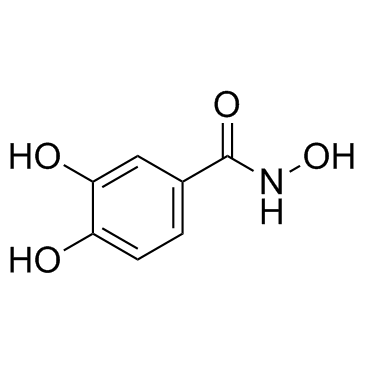
Didox
CAS No. 69839-83-4
Didox( 3,4-Dihydroxybenzohydroxamic acid )
Catalog No. M15680 CAS No. 69839-83-4
A ribonucleotide reductase inhibitor; overcomes Bcl-2 mediated radiation resistance in PC-3 cells.
Purity : >98% (HPLC)
 COA
COA
 Datasheet
Datasheet
 HNMR
HNMR
 HPLC
HPLC
 MSDS
MSDS
 Handing Instructions
Handing Instructions
| Size | Price / USD | Stock | Quantity |
| 5MG | 42 | In Stock |


|
| 10MG | 58 | In Stock |


|
| 25MG | 125 | In Stock |


|
| 50MG | 192 | In Stock |


|
| 100MG | 295 | In Stock |


|
| 500MG | 710 | In Stock |


|
| 1G | Get Quote | In Stock |


|
Biological Information
-
Product NameDidox
-
NoteResearch use only, not for human use.
-
Brief DescriptionA ribonucleotide reductase inhibitor; overcomes Bcl-2 mediated radiation resistance in PC-3 cells.
-
DescriptionA ribonucleotide reductase inhibitor; overcomes Bcl-2 mediated radiation resistance in PC-3 cells; induces apoptosis and inhibits DNA repair in multiple myeloma cells by downregulation of bcl family proteins including bcl-2, bcl(xl), and XIAP; (150 mg/kg daily) significantly protects the cardiomyocyte membrane integrity and decreases the intra-cardiac oxidative stress induced by DOX treatment (15 mg/kg) in mice.
-
In VitroDidox (NSC-324360) suppresses LPS-induced mRNA levels of iNOS, IL-6, IL-1, TNF-α, NF-κβ (p65), and p38-α, after 24 h of treatment. Treatment with Didox also suppresses the secretion of nitric oxide (NO), IL-6, and IL-10. Using mitochondrial dehydrogenase activity as a measure of cytotoxicity, the effects of Didox on cellular respiration in RAW264.7 are examined over a range of concentrations for 24 h. Cells exposures to 200 μM and below Didox, with and without LPS, do not exhibit significant cellular toxicity. Didox (NSC-324360) is active against all human and murine acute myeloid leukemia (AML) lines tested with IC50 values in the low micromolar range (mean IC50 37 μM [range 25.89-52.70 μM]).
-
In VivoOnce engraftment is established by bioluminescent imaging, the animals receive daily administrations of Didox at 425 mg/kg via IP injection over 5 days. Didox (NSC-324360) treatment significantly reduces leukemic burden compared to vehicle treated controls (p=0.0026 and p=0.0342). More importantly, Didox (NSC-324360) provides a significant survival benefit (p<0.0001 and p=0.0094).
-
Synonyms3,4-Dihydroxybenzohydroxamic acid
-
PathwayApoptosis
-
TargetNF-κB
-
RecptorNF-κB
-
Research AreaCancer
-
Indication——
Chemical Information
-
CAS Number69839-83-4
-
Formula Weight169.1348
-
Molecular FormulaC7H7NO4
-
Purity>98% (HPLC)
-
Solubility10 mM in DMSO
-
SMILESO=C(NO)C1=CC=C(O)C(O)=C1
-
Chemical NameBenzamide, N,3,4-trihydroxy-
Shipping & Storage Information
-
Storage(-20℃)
-
ShippingWith Ice Pack
-
Stability≥ 2 years
Reference
1. Inayat MS, et al. Cancer Biol Ther. 2002 Sep-Oct;1(5):539-45.
2. Raje N, et al. Br J Haematol. 2006 Oct;135(1):52-61.
3. Al-Abd AM, et al. Eur J Pharmacol. 2013 Oct 15;718(1-3):361-9.
molnova catalog



related products
-
Andrographolide
Andrographolide(Andrographis) is an irreversible antagonist of NF-κB and prevents in vitro T cell activation.
-
Ginsenoside Rb1
Ginsenoside Rb1 is part of a class of steroid glycosides; may have properties that inhibit or prevent the growth of tumors.
-
Atractylodin
Atractylodin has high lipase inhibitory activity (IC5:39.12?μM); Atractylodin possesses strong repellency activities against T. castaneum adults (LD50: 1.83?μg/cm).



 Cart
Cart
 sales@molnova.com
sales@molnova.com


